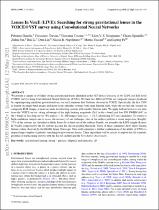| dc.identifier.citation | Gentile, F., Tortora, C., Covone, G., Koopmans, L., Spiniello, C., Fan, Z., Li, R., Liu, D., Napolitano, N., Vaccari, M. and Fu, L., 2021. Lenses In VoicE (LIVE): searching for strong gravitational lenses in the VOICE@VST survey using convolutional neural networks. Monthly notices of the Royal Astronomical Society, 510(1), pp.500-514. | en_US |
| dc.description.abstract | We present a sample of 16 likely strong gravitational lenses identified in the VST Optical Imaging of the CDFS and ES1 fields (VOICE survey) using Convolutional Neural Networks (CNNs). We train two different CNNs on composite images produced by superimposing simulated gravitational arcs on real Luminous Red Galaxies observed in VOICE. Specifically, the first CNN is trained on single-band images and more easily identifies systems with large Einstein radii, while the second one, trained on composite RGB images, is more accurate in retrieving systems with smaller Einstein radii. We apply both networks to real data from the VOICE survey, taking advantage of the high limiting magnitude (26.1 in the r-band) and low PSF FWHM (0.8" in the r-band) of this deep survey. We analyse ∼ 21, 200 images with 𝑚𝑎𝑔𝑟 < 21.5, identifying 257 lens candidates. To retrieve a high-confidence sample and to assess the accuracy of our technique, nine of the authors perform a visual inspection. Roughly 75% of the systems are classified as likely lenses by at least one of the authors. Finally, we assemble the LIVE sample (Lenses In VoicE) composed by the 16 systems passing the chosen grading threshold. Three of these candidates show likely lensing features when observed by the Hubble Space Telescope. This work represents a further confirmation of the ability of CNNs to inspect large samples of galaxies searching for gravitational lenses. These algorithms will be crucial to exploit the full scientific potential of forthcoming surveys with the Euclid satellite and the Vera Rubin Observatory. | en_US |

